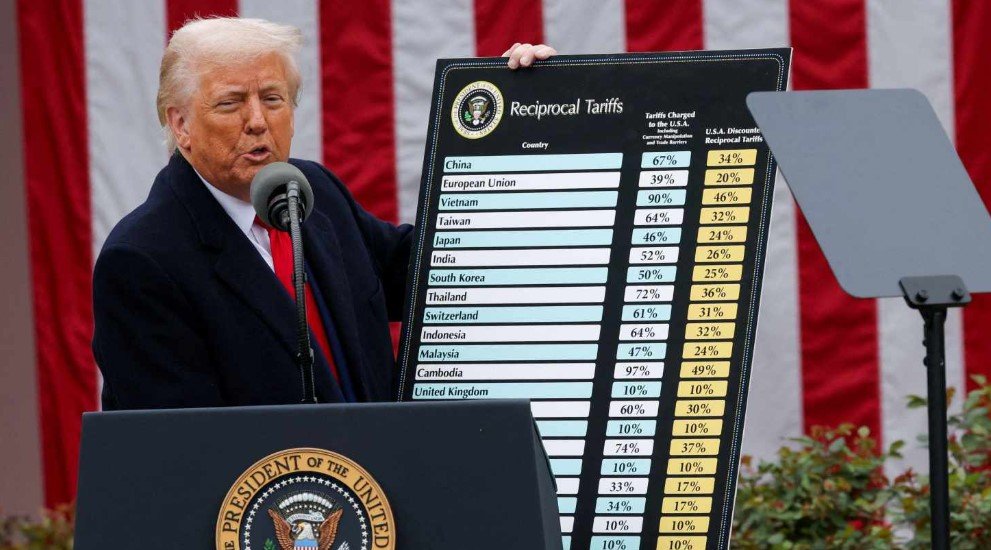With just days to go, trade deal hangs in balance as pressure mounts on New Delhi and Washington
Donald Trump isn’t ruling anything out. Speaking to reporters on Tuesday evening, the former president said India could face tariffs as high as 25%—but quickly added that nothing had been finalized yet.
It’s not the first time he’s played both the hardliner and the dealmaker. But the clock is ticking. The U.S. and India have been trying to hammer out a limited trade deal ahead of an August 1 deadline, and Trump’s latest remarks suggest that things are far from settled.
A blunt warning—but not a done deal
Trump’s comments came in response to a question about whether India might be hit with a 20% to 25% tariff. “I think so,” he said, pausing. Then he clarified: “We’re still working on it. It’s not done.”
That ambiguity has become something of a hallmark for him—tough rhetoric upfront, hedged just enough to leave room for compromise. Still, it sent a chill through New Delhi and rattled some nerves among trade lobbyists watching the talks closely.
India, which had been hoping to avoid a dramatic escalation, now faces the prospect of steep duties on key exports—unless negotiators can pull something off in the 11th hour.
Delhi’s exports could take a direct hit
If the tariffs go through, they could affect a wide range of Indian products—from textiles to electronics to auto parts. India is already navigating a tough global trade environment. U.S. tariffs would only make it worse.
One Indian trade official, speaking anonymously, said they were “blindsided” by the sudden hike in tariff figures. Until recently, discussions were centered on smaller numbers.
The U.S. side, meanwhile, appears to be holding firm. “India has to play fair,” said a senior U.S. trade official, who also declined to be named. “We want access, reciprocity, and real reforms—not just words.”

What’s holding up a deal?
So what’s the holdup? It’s not just one thing. Sources close to the talks point to several sticking points:
-
U.S. demands for greater access to India’s dairy and agricultural sectors.
-
Indian concerns over data localization and digital taxation.
-
Disagreements over pharma regulation, especially around generics.
There’s also a lack of political will on both sides, some experts say. With India entering a sensitive phase ahead of state elections and Trump focused on his 2024 campaign strategy, domestic optics matter just as much as policy.
“Neither side wants to look like they caved,” said trade analyst Shruti Bansal. “But time is running out.”
Table: Key Indian exports that could face Trump’s proposed tariffs
| Product Category | Annual Export to U.S. (USD) | Potential Tariff Impact |
|---|---|---|
| Textiles & Apparel | $9.4 billion | Could lose competitiveness |
| Pharmaceuticals | $6.7 billion | May face compliance delays |
| Electronics | $5.1 billion | Parts cost could rise |
| Auto Components | $3.2 billion | Tariffs may reduce volume |
| Jewelry | $11.5 billion | High risk of disruption |
One sentence here. It’s not just numbers; these are jobs and livelihoods.
Trump’s tariff card: Strategy or stall?
Trump’s tariff talk isn’t new. It’s been a favored tactic of his since the China trade war. Announce the threat, watch the markets react, then use that leverage to extract concessions.
But this time, the results are underwhelming. With just a few days left, only a handful of small deals have been reached—and none touch the bigger issues.
It’s left many wondering: is this even about trade anymore? Or is it political theater?
“If you wanted a breakthrough, you’d see real movement on both sides,” said economist Rajeev Mehta. “Instead, we see posturing.”
Still, Trump’s comments do carry weight. U.S. businesses that rely on Indian imports are already bracing for the worst.
India’s possible moves—and what’s at stake
New Delhi, for its part, has been quiet. Officials are still evaluating options. One possibility being floated: retaliatory tariffs on American farm goods and tech products.
That’s a risky move. It could escalate tensions and drag out negotiations even longer.
At the same time, India also has reasons to hold the line. With the U.S. now India’s largest trading partner, any long-term friction could hurt both sides.
A trade ministry source said they are “still hopeful” a limited agreement can be stitched together before the deadline. But optimism is fading by the hour.
Not the first standoff, but maybe the costliest
This isn’t the first time the U.S. and India have butted heads over trade. Previous flare-ups have involved medical devices, data rules, and agricultural access.
But this time feels different. Both sides are under domestic pressure. Both are playing to their political bases. And neither wants to blink first.
In 2019, Trump revoked India’s duty-free trade privileges under the Generalized System of Preferences (GSP) program. New Delhi responded with tariffs on U.S. almonds and apples.
That tit-for-tat dragged on for nearly two years. Analysts worry this time could be even more drawn out.
Businesses left guessing, again
For companies caught in the middle, the lack of clarity is exhausting.
One Mumbai-based garment exporter said they had three large U.S. orders on hold, waiting to see what happens. “I can’t ship at 25%. That kills the margin,” he said.
Across the board, importers, exporters, logistics firms and even e-commerce platforms are in wait-and-watch mode.
The bigger question is how long that wait lasts.
